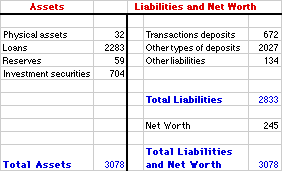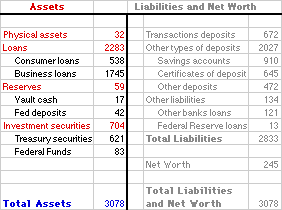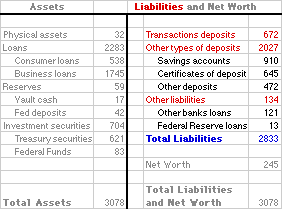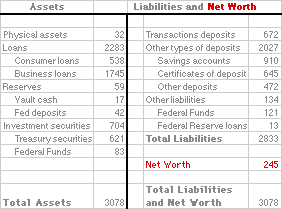
|
|
MARKET EFFICIENCY: The notion that a competitive market automatically achieves an efficient allocation of resources by equating demand price with supply price and quantity demanded with quantity supplied. Market efficiency relies on the self-correction process that eliminates shortages or surpluses. It also presumes that the market is competitive and is not subject to assorted market failures.
Visit the GLOSS*arama
|
|


|

|
                           BANK BALANCE SHEET: A record of the assets, liabilities, and net worth of a bank at a given point in time. Assets are what a bank owns. Liabilities are what a bank owes. Net worth is the difference between the two and what is claimed by or owed to the owners of the bank. By definition, a balance sheet must balance. The assets on one side are equal to the liabilities and net worth on the other. The balance sheet of a bank is a snapshot of its financial condition. Assets are listed on one side of the balance sheet (usually the left-hand side), while liabilities and net worth are listed on the other (the right-hand side). Both sides of the balance sheet are equal--they MUST be equal. This equality is achieved through net worth, which is defined as the difference between assets and liabilities.If assets exceed liabilities, then net worth is positive. If liabilities exceed assets, then net worth is negative. While the balance sheet for any business is important, it is particularly important for a bank. All firms seek to "manipulate" their balance sheets in such a way that net worth increases. They do this indirectly by combining resources, producing goods, then selling these goods to generate revenue. A bank is able to modify its balance sheet more directly. The primary productive activity of a bank is to manipulate its balance sheet by "creating" assets and liabilities, which it does this by making loans. Each loan entails the creation of an asset on one side of the balance sheet (the loan) balanced by an equal liability on the other side (usually a checking account deposit). A Representative, Hypothetical Balance Sheet| OmniBank Balance Sheet |  |
A representative, hypothetical balance sheet for OmniBank (a representative, hypothetical bank) is presented in the exhibit to the right. Before getting into the details, consider a few general observations: - First, note that the OmniBank balance sheet is divided into two sides--assets on the left and liabilities and net worth on the right. As a "balance" sheet, both sides are equal--they balance. A balance sheet must balance. Add something, subtract something. Keep it in balance. This handy equation summarizes the balance of assets (A) with liabilities (L) and net worth (NW):
A = L + NW
- Second, the crux of a balance sheet is the division between assets, liabilities, and net worth.
The assets on the left-hand side of the balance sheet are what OmniBank owns. The primary asset categories of a bank are loans, reserves, investment securities, and physical assets (such as buildings, desks and computers). Liabilities on the right-hand side of the balance sheet are what OmniBank owes. The most important liabilities are deposits, especially transactions deposits (that is, checking accounts). Net worth, also on the right-hand side of the balance sheet, is then the difference between assets and liabilities. In effect, net worth is what the bank owes to the owners of OmniBank. Another way of looking at this balance sheet equality is that assets, what the bank owns, are divided between liabilities, what the bank owes to others, and net worth, what the banks owes to the owners.
- Third, as a profit-seeking business, OmniBank's primary duty is to adjust these assets and liabilities to acquire profit. Of course, ALL businesses acquire profit by adjusting assets and liabilities. They boost revenue assets and reduce cost liabilities. But, unlike other types of producers, banks do not make adjustments with real production. In fact, the accounting process of adjusting entries in the balance sheet IS OmniBank's production. OmniBank's business is to change these entries.
Assets| OmniBank Assets |  |
OmniBank assets are, of course, what a bank owns. OmniBank, being a representative bank, has four main categories of assets listed on the balance sheet at the right:- Physical Assets: This includes the buildings, land, furniture, and equipment owned by the bank. While this is what most people probably think of as assets, it is relatively minor for most banks.
- Loans: The second asset category, the most important one for all banks, is loans. Loans are the primary source of interest revenue. While a loan is a liability for the borrower, it is an asset for the bank, for the lender. This asset includes loans to consumers (home loans, personal loans, automobile loans, credit card loans) and businesses (real estate development loans, capital investment loans).
- Reserves: The third asset category is reserves. While this is small in amount, it is extremely important. Reserves are what banks use for daily transactions, such as processing checks or satisfying cash withdrawals. Banks use reserves to ensure the security of deposits. Two varieties of reserves are worth noting vault cash (the actual paper currency and coins that is kept in the bank, that is, in the vault) and Federal Reserve deposits (deposits that banks keep with the Federal Reserve System to clear checks and assist in other banking activities).
- Investment Securities: The fourth asset category is investment securities. These act as a buffer between loans and reserves. They are safer than loans, but not as safe as reserves. They pay more interest than reserves, but not as much as loans. If a bank has a few extra reserves, but is not ready to lock in loans for the long term, then investment securities are the answer. Two important items in this category are U.S. Treasury securities (the securities that the federal government issues to borrow the funds used to finance the federal deficit) and Federal funds (loans made to other banks).
Liabilities| OmniBank Liabilities |  |
On the other side of the Omnibank's balance sheet is liabilities, what a bank owes. Liabilities are generally separated into three categories:- Transactions Deposits: The most important liability is transactions deposits. This, of course, is the technical name for checking accounts or checkable deposits. Make note that while checking accounts are assets for customers, they are liabilities for OmniBank. OmniBank owes these deposits to customers. Transaction deposits deserve a separate listing in the balance sheet because they are part of the M1 money supply.
- Other Types Of Deposits: As a full-service bank, OmniBank has other types of deposits, too. OmniBank offers savings accounts, certificates of deposit, money market deposits, repurchase agreements, and a host of other accounts that find their way into the M2 and M3 monetary aggregates.
- Other Liabilities: Most banks also have a few other liabilities. Specifically OmniBank might borrow from sources other than typical household and business customers that provide deposits. Two common sources of funds are Federal funds loans (loans from other banks) and Federal Reserve loans (loans from the Federal Reserve System).
Net Worth| OmniBank Net Worth |  |
Before leaving the OmniBank balance sheet a word or two about net worth is in order. Net worth can be thought of as what the bank owes the owners. Observe that the OmniBank net worth is in fact positive.This, of course, is good news. A negative net worth would put OmniBank in jeopardy of bankruptcy--on the verge of closing down. And if it did, depositors then run the risk of losing the financial wealth that they entrusted to OmniBank for safekeeping. That could be bad for them and bad for the economy. If they lose checking account deposits, then the economy loses M1 money. That is why a negative net worth also attracts intense scrutiny from banking regulators. And that is why OmniBank has a item called loan loss reserves. While it is usually included under net worth, it is really a buffer that OmniBank has set aside, apart from the net worth, that belongs to the owners, just in case problems arise. Loan loss reserves come in handy just in case some of those credit card, shopping mall construction, or oil drilling loans are not repaid. Should these borrowers default, OmniBank can adjust the loan loss reserve without a need to adjust either deposits, which would upset customers, or net worth, which would upset the owners.

Recommended Citation:BANK BALANCE SHEET, AmosWEB Encyclonomic WEB*pedia, http://www.AmosWEB.com, AmosWEB LLC, 2000-2025. [Accessed: July 1, 2025].
Check Out These Related Terms... | | | | | | | |
Or For A Little Background... | | | | | | | | | | |
And For Further Study... | | | | | | |
Related Websites (Will Open in New Window)... | | |
Search Again?
Back to the WEB*pedia
|



|

|
BROWN PRAGMATOX
[What's This?]
Today, you are likely to spend a great deal of time lost in your local discount super center trying to buy either clothing for your kitty cats or a set of luggage without wheels. Be on the lookout for infected paper cuts.
Your Complete Scope
This isn't me! What am I?
|

|
|
Two and a half gallons of oil are needed to produce one automobile tire.
|

|
|
"Experience keeps a dear school, but fools will learn in no other. " -- Benjamin Franklin
|

|
EBIT
Earnings Before Interest and Taxes
|

|
|
Tell us what you think about AmosWEB. Like what you see? Have suggestions for improvements? Let us know. Click the User Feedback link.
User Feedback
|


|


